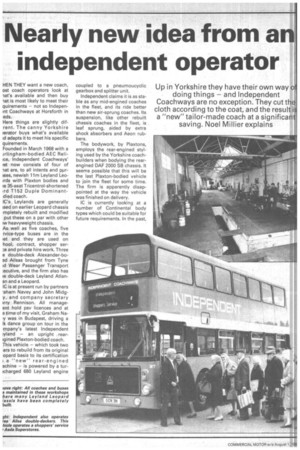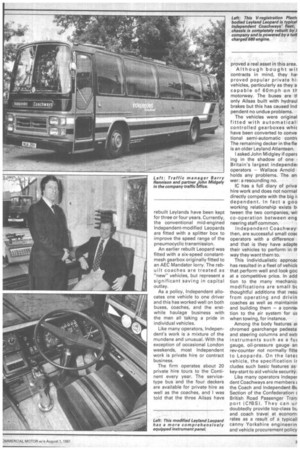Nearly new idea from an independent operator
Page 24

Page 25

If you've noticed an error in this article please click here to report it so we can fix it.
Up in Yorkshire they have their own way o doing things — and Independent Coachways are no exception. They cut the cloth according to the coat, and the result i a "new" tailor-made coach at a significant saving. Noel Millier explains
HEN THEY want a new coach, ost coach operators look at iat's available and then buy iat is most likely to meet their quirements — not so Indepen nt at Horsforth in eds.
Here things are slightly difrent. The canny Yorkshire ierator buys what's available id adapts it to meet his specific quirements.
Founded in March 1968 with a 'Hingham-bodied AEC ReMice, Independent Coachways' ;et now consists of four of -.tat are, to all intents and ourises, newish llm Leyland Leoirds with Plaxton bodies and le 35-seat Tricentrol-shortened ird T152 Duple Dominantdied coach.
IC's Leylands are generally ised on earlier Leopard chassis r-tIpletely rebuilt and modified put these on a par with other iw heavyweight chassis.
As well as five coaches, five rvice-type buses are in the at and they are used on hool, contract, shopper sera and private hire work. Three a double-deck Alexander-hoad Ailsas brought from Tyne id Wear Passenger Transport :ecutive, and the firm also has le double-deck Leyland Atlanan and a Leopard.
IC is at present run by partners 'ahem Navey and John Midgy, and company secretary irry Rennison. All manageant hold pay licences and at e time of my visit, Graham Nay was inBudapest, driving a lk dance group on tour in the mpany's latest Independent ylartd — an upright rearigined Plaxton-bodied coach. This vehicle — which took two ars to rebuild from its original opard basis to its certification ; a "new" rear-engined achine — is powered by a tur'charged 650 Leyland engine coupled to a pneumoucyclic gearbox and splitter unit.
Independent claims it is as stable as any mid-engined coaches in the fleet, and its ride better than new air-sprung coaches. Its suspension, like other rebuilt chassis coaches in the fleet, is leaf sprung, aided by extra shock absorbers and Aeon rubbers.
The bodywork, by Plaxtons, employs the rear-engined styling used by the Yorkshire coachbuilders when bodying the rearengined DAF 2000 SB chassis. It seems possible that this will be the last Plaxton-bodied vehicle to join the fleet for some time. The firm is apparently disappointed at the way the vehicle was finished on delivery.
IC is currently looking at a number of Continental body types which could be suitable for future requirements. In the past, rebuilt Leylands have been kept for three or four years. Currently, the conventional mid-engined Independent-modified Leopards are fitted with a splitter box to improve the speed range of the pneumocyclic transmission.
An earlier rebuilt Leopard was fitted with a six-speed constant mesh gearbox originally fitted to an AEC Mandator lorry. The rebuilt coaches are treated as "new" vehicles, but represent a significant saving in capital outlay.
As a policy, Independent allocates one vehicle to one driver and this has worked well on both buses, coaches, and the erstwhile haulage business with the men all taking a pride in individual vehicles.
Like many operators, Independent's work is a mixture of the mundane and unusual. With the exception of occasional London weekends, most independent work is private hire or contract business.
The firm operates about 20 private hire tours to the Continent every year. The service.
type bus and the four deckers are available for private hire as well as the coaches, and I was told that the three Ailsas have proved a real asset in this area. Although bought wit contracts in mind, they has proved popular private hi! vehicles, particularly as they a capable of 60mph on motorway. The buses are tt only Ailsas built with hydraul brakes but this has caused Ind pendent no undue problems.
The vehicles were original fitted with automaticall
controlled gearboxes whic have been converted to conve tional semi-automatic contr.( The remaining decker in the fle is an older Leyland Atlantean.
I asked John Midgley if operE log in the shadow of one Britain's largest independei operators — Wallace Arnold holds any problems. The an wer: a resounding no.
IC has a full diary of priva hire work and does not normal directly compete with the big ii
dependent. In fact a goo working relationship exists b,
tween the two companies, wil co-operation between eng neering staff common.
Independent Coachway: then, are successful small coac operators with a difference and that is they have adaptc their vehicles to perform in th way they want them to.
This individualistic approac has resulted in a fleet of vehicIE that perform well and look goo at a competitive price. In add tion to the many mechanic.
modifications are small lot thoughtful additions that resu from operating and drivin
coaches as well as maintainin and building them — a corm& tion to the air system for Us when towing, for instance.
Among the body features ar chromed gearchange pedesta and steering columns and extr instruments such as a fu( gauge, oil-pressure gauge an rev-counter not normally fitte to Leopards. On the late:E vehicle, the specification ir dudes such basic features as key-start to aid vehicle security.
Like many operators lndeper dent Coachways are members( the Coach and Independent Bu Section of the Confederation c British Road Passenger Tram port (CITS). They can ur doubtedly provide top-class bu and coach travel at economi rates as a result of a typicall canny Yorkshire engineerin and vehicle procurement policy








































